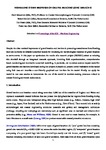Modelling storm response on gravel beaches using XBeach-G
| dc.contributor.author | Masselink, Gerd | |
| dc.contributor.author | McCall, R | |
| dc.contributor.author | Poate, Tim | |
| dc.contributor.author | van Geer, P | |
| dc.date.accessioned | 2014-12-09T15:33:45Z | |
| dc.date.available | 2014-12-09T15:33:45Z | |
| dc.date.issued | 2014-12-01 | |
| dc.identifier.issn | 1741-7597 | |
| dc.identifier.issn | 1751-7737 | |
| dc.identifier.uri | http://hdl.handle.net/10026.1/3172 | |
| dc.description | EPRSC New Understanding and Prediction of Storm Impacts on Gravel beaches (NUPSIG; EP/H040056/1) and Adaptation and Resilience of Coastal Energy Supply (ARCEoS; EP/IO35390/1). The full text is under embargo until 01.12.15. Published by ICE Publishing | |
| dc.description.abstract |
<jats:p> Despite the clear societal importance of gravel beaches and barriers in protecting coastal areas from flooding, there are currently no reliable numerical models for predicting the morphological response of gravel beaches to storm events. This paper synthesises the results of a research project (NUPSIG) aimed at reducing this shortfall through an integrated research approach, involving field experimentation, comprehensive beach monitoring and innovative numerical modelling. In particular, the authors introduce a storm impact model for gravel beaches and barriers developed during the project (XBeach-G), present a brief validation of the model using field data and describe a user-friendly graphical user interface for the model. Finally, the model is applied in two case studies to demonstrate the use of the model in decision-making processes related to coastal flooding and beach maintenance. </jats:p> | |
| dc.format.extent | 173-191 | |
| dc.language | en | |
| dc.language.iso | en | |
| dc.publisher | Thomas Telford Ltd. | |
| dc.subject | coastal engineering | |
| dc.subject | geology | |
| dc.subject | hydraulics & hyrdodynamics | |
| dc.title | Modelling storm response on gravel beaches using XBeach-G | |
| dc.type | journal-article | |
| dc.type | Article | |
| plymouth.author-url | http://www.icevirtuallibrary.com/content/journals/m;jsessionid=kl02hx3tnmu3.x-telford-live-01? | |
| plymouth.issue | 4 | |
| plymouth.volume | 167 | |
| plymouth.publication-status | Published | |
| plymouth.journal | Proceedings of the ICE - Maritime Engineering | |
| dc.identifier.doi | 10.1680/maen.14.00020 | |
| plymouth.organisational-group | /Plymouth | |
| plymouth.organisational-group | /Plymouth/Faculty of Science and Engineering | |
| plymouth.organisational-group | /Plymouth/Faculty of Science and Engineering/School of Biological and Marine Sciences | |
| plymouth.organisational-group | /Plymouth/REF 2021 Researchers by UoA | |
| plymouth.organisational-group | /Plymouth/REF 2021 Researchers by UoA/UoA07 Earth Systems and Environmental Sciences | |
| plymouth.organisational-group | /Plymouth/Research Groups | |
| plymouth.organisational-group | /Plymouth/Research Groups/Marine Institute | |
| plymouth.organisational-group | /Plymouth/Users by role | |
| plymouth.organisational-group | /Plymouth/Users by role/Academics | |
| plymouth.organisational-group | /Plymouth/Users by role/Researchers in ResearchFish submission | |
| dc.identifier.eissn | 1751-7737 | |
| dc.rights.embargoperiod | Not known | |
| rioxxterms.funder | Engineering and Physical Sciences Research Council | |
| rioxxterms.identifier.project | New Understanding and Predicting Storm Impacts on Gravel beaches | |
| rioxxterms.versionofrecord | 10.1680/maen.14.00020 | |
| rioxxterms.licenseref.uri | http://www.rioxx.net/licenses/all-rights-reserved | |
| rioxxterms.type | Journal Article/Review | |
| plymouth.funder | New Understanding and Predicting Storm Impacts on Gravel beaches::Engineering and Physical Sciences Research Council |


